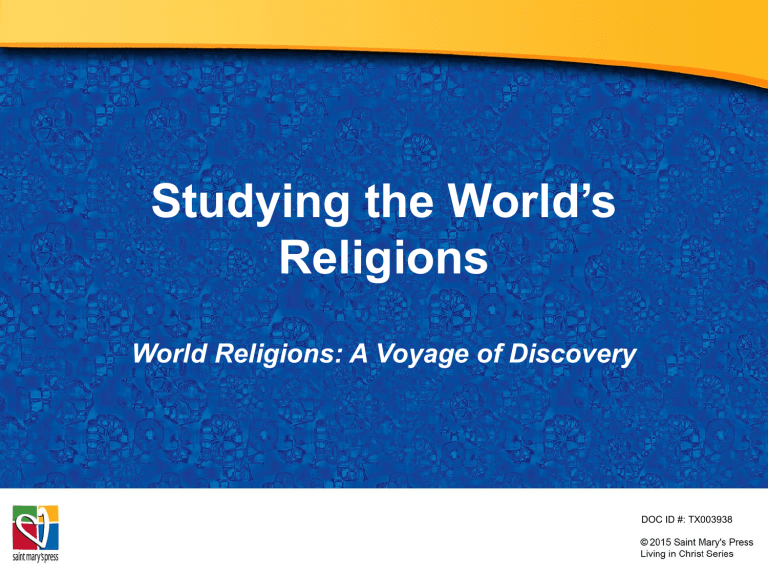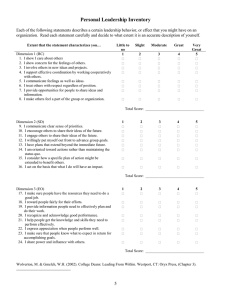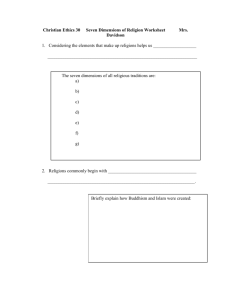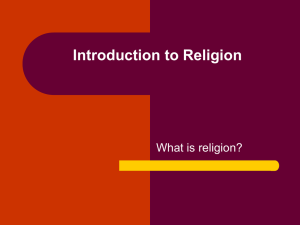
Studying the World’s Religions World Religions: A Voyage of Discovery DOC ID #: TX003938 Academic Study of Religion • Modern universities emerged from institutions in Europe that integrated religious pursuits with academic study. • Today, academic study of religion is commonly distinctive from doing religion. • The academic study of religion emphasizes free inquiry and critical examination. © Andrei Nekrassov / www.shutterstock.com The Doctrinal Dimension: Ultimate Reality • The doctrinal dimension of religion includes beliefs about ultimate reality. • Most religions are either theistic or nontheistic. • Most Hindus, for example, are polytheists while also being monists. © Malgorzata Kistryn / www.shutterstock.com The Experiential Dimension © BasPhoto / www.shutterstock.com • Moses’ encountering the Burning Bush is an example of the experiential dimension. • Moses had an encounter with God and a mystical experience. • This event is set forth in the sacred narrative of the Book of Exodus and therefore also involves the mythic dimension. The Ethical Dimension: The Golden Rule • Christianity’s “Golden Rule” is set forth in Matthew 7:12. • Many of the world’s religions embrace basically the same teaching. • Comparing similarities and differences among religions is highly instructive. cstar55 / www.istockphoto.com The Ritual Dimension: Prayer and Meditation • Prayer and meditation are practiced extensively by Buddhists. • Prayer is more common in theistic religions, meditation in nontheistic religions. • Prayer and meditation also commonly involve the experiential dimension. © Cyril Hou / www.shutterstock.com The Ritual and Social Dimensions: A Marriage Ceremony • Life’s important transitions often are marked by religious rituals. • Marriage ceremonies ritually sanctify the transition in the presence of family and community, helping to secure societal affirmation of the couple’s new status. • Marriage affects the societal structure of the community. © Lily Rosen - Zohar / www.shutterstock.com T’ai Chi • In China, t’ai chi is often practiced in public places. • T’ai chi is commonly practiced for such nonreligious objectives as improving health and providing self-defense. • T’ai chi nonetheless has religious roots in the Taoist tradition. TonyV3112 / www.shutterstock.com Yoga • In Hinduism, yoga is an important example of the ritual dimension of religion. • For many in the West, yoga is a form of exercise and relaxation and is not religious. • Traditional religious and modern secular aspects intermingle in yoga. © Kiselev Andrey Valerevich / www.shutterstock.com The Material Dimension: Earth © leonello calvetti / www.shutterstock.com • The material dimension of religion includes natural entities. • Some religions regard the earth as sacred. • Other religions regard the earth as part of the creative work of God (or gods). • The earth also symbolizes the plurality of religions around the globe. The Material Dimension: Religious Symbols and Civil Religion • United States currency bears the statement “In God We Trust.” • The First Amendment to the U.S. Constitution mandates separation of church and state. • “In God We Trust” suggests a kind of “civil religion.” © Asaf Eliason /www.shutterstock.com The Material Dimension: Hindu Religious Symbolism • The government of India has issued postage stamps with religious symbolism. • The Hindu trimurti features the gods Brahma, Vishnu, and Shiva. • Compare “In God We Trust” on United States currency. brandonht / www.shutterstock.com The Material Dimension: Devils Tower • Devils Tower is a sacred entity for many tribes of the North American Plains. • For others, Devils Tower is a popular tourist destination. • The material dimension of religion encompasses natural and manmade entities. © Tom Grundy /www.shutterstock.com





